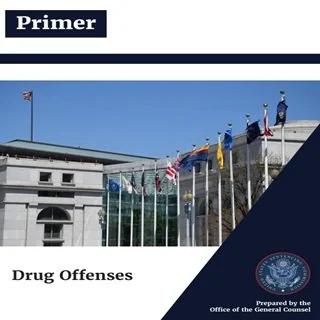By the United States Sentencing Commission
This is the twenty-ninth edition of the United States Sentencing Commission’s Sourcebook of Federal Sentencing Statistics. This Sourcebook contains descriptive statistics on the application of the federal sentencing guidelines and provides selected district, circuit, and national sentencing data. The volume covers fiscal year 2024 (October 1, 2023, through September 30, 2024, hereinafter “2024”). This Sourcebook, together with the 2024 Annual Report, constitutes the annual report referenced in 28 U.S.C. § 997, as well as the analysis, recommendations, and accounting to Congress referenced in 28 U.S.C. § 994(w)(3). The Commission received documentation on 61,678 federal felony and Class A misdemeanor cases involving individuals sentenced in fiscal year 2024.1 The Commission coded and edited information from the sentencing documents in these cases into its comprehensive, computerized data collection system. The Commission first released sentencing data in its 1988 Annual Report and reported this data annually until 1996. That year, the Commission compiled sentencing data into a new publication, the Sourcebook of Federal Sentencing Statistics. In 2019, the Sourcebook edition reporting fiscal year 2018 data was substantially revised and expanded. Existing tables were revised to reflect current sentencing practices. Many figures were updated to make them easier to understand and were presented in color while others were removed and the data on them presented in new ways. Additional analyses regarding drug and immigration crimes were added, and new sections on firearms and economic offenses were included. Trend analyses were added to each of the major sections to show how sentencing patterns had changed over the last ten years. The section on Sentenced Organizations was also expanded. Finally, Appendix B, which provides sentencing data for each judicial district, was completely redesigned to reflect current sentencing practices. Beginning with that 2018 Sourcebook, the Commission made important methodological changes in the way the data was presented. Principal among them was the way cases were assigned to a “type of crime” (previously called offense type). Beginning with fiscal year 2018 data, the guideline (or guidelines) that the court applied in determining the sentence determines the crime type category to which a case is assigned. Also, the names of some of the crime type categories were revised and some outdated categories were removed from the tables and figures. Another important methodological change was that sentences were capped at 470 months for all analyses. Additionally, cases involving the production of child pornography were reassigned to the sexual abuse crime type. Previously, these cases were assigned to the child pornography offense type in the Sourcebook. Finally, beginning with the 2018 Sourcebook, the methodology used to analyze the sentence imposed relative to the sentencing range for the case as determined under the Commission’s Guidelines Manual was substantially revised. Sentences now are grouped into two broad categories: Sentences Under the Guidelines Manual and Variances. The former category comprises all cases in which the sentence imposed was within the applicable guideline range or, if outside the range, where the court cited one or more of the departure reasons in the Guidelines Manual as a basis for the sentence. Variance cases are those in which the sentence was outside the guideline range (either above or below) and where the court did not cite any guideline reason for the sentence. Data for important subgroups within these two categories are also reported. Because of these methodological changes, direct comparisons between data for Sourcebooks from fiscal year 2018 and later years cannot always be made to data reported in the Sourcebooks for years before fiscal year 2018. This year, the Commission has made substantial revisions to the section on sentencing appeals. Beginning with 2024 data, the Commission is no longer collecting information about the guideline forming the basis for reversal or remand in sentencing appeals, or the reasonableness issues appealed in cases where the original sentence was reversed or remanded. Tables providing that information have been removed from the 2024 Sourcebook. Also beginning with 2024 data, the Commission has changed the way it categorizes appeals cases in which a brief was submitted by counsel for the defendant pursuant to the Supreme Court decision in Anders v. California, 386 U.S. 738 (1967). Previously, “Anders Brief” cases were reported as a type of appeal. Beginning with the 2024 data, the Commission has sought to determine the type of appeal involved in an Anders Brief case (e.g., an appeal of the sentence only) and, when that information was available, has classified the case accordingly. Cases in which an Anders brief was filed, but where the sentencing documentation did not indicate the type of appeal, now are classified as “Unknown” types of appeals and are excluded from the data reported on Figure A and the remaining tables. Also, this year the Commission is providing new information in the sentencing appeals section. New Figure A-2 reports additional information on the type of sentence that was appealed. Sentences are classified into three categories: appeals of the original sentence, appeals of an order deciding a motion for a resentencing or other modification of sentence, and appeals of a revocation of probation or supervised release. In appeals of an order deciding a motion for a resentencing or other modification of sentence, the Commission reports the basis asserted in the motion. Additionally, while the Commission has always reported the disposition of sentencing appeals of the original sentence on Table A-2, the Commission now is reporting information on the disposition of post-sentencing motion appeals on Table A-2A. New Figure A-3 provides information about the type of crime involved in appeals of original sentences. While this data was previously available on another table, and continues to be reported on Table A-5, new Figure A-3 presents this information graphically. New Table A-6 reports data on the position of the sentence relative to the guideline range in original sentencing appeals, using the Commission’s standard classifications found on Table 29 of the Sourcebook for original sentences. Finally, the numbers and titles of the remaining tables in the section were revised for clarity.
Washington, DC: USSC, 2025. 201p.




